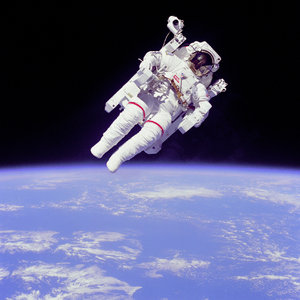Thrusters
Not everything in space flight needs a huge rocket motor, sometimes we have to be far more delicate. Typical jobs involve changing the direction a satellite is pointing in (but not travelling in) or giving it a very gentle nudge when it is docking with another satellite. These low force rocket motors are usually called 'thrusters'.

Cold gas systems
The simplest form of thruster is little more than a container of pressurised gas. It is very like the balloon you saw earlier. When thrust is needed some of the pressurised gas is released through the nozzle. Typical gases used are nitrogen, argon, freon and propane. It is important to make sure that the gas will not damage any components that it might land on such as solar cells, sensors or even an astronaut’s space suit! Because the gas is cold the thrust is very low, typically around 10 mN (around the weight of a one gram mass on Earth) and the specific impulse is only around 50 s at best. Bigger units have been used to allow astronauts to move freely outside the space shuttle and the ISS.















 Germany
Germany
 Austria
Austria
 Belgium
Belgium
 Denmark
Denmark
 Spain
Spain
 Estonia
Estonia
 Finland
Finland
 France
France
 Greece
Greece
 Hungary
Hungary
 Ireland
Ireland
 Italy
Italy
 Luxembourg
Luxembourg
 Norway
Norway
 The Netherlands
The Netherlands
 Poland
Poland
 Portugal
Portugal
 Czechia
Czechia
 Romania
Romania
 United Kingdom
United Kingdom
 Slovenia
Slovenia
 Sweden
Sweden
 Switzerland
Switzerland

































